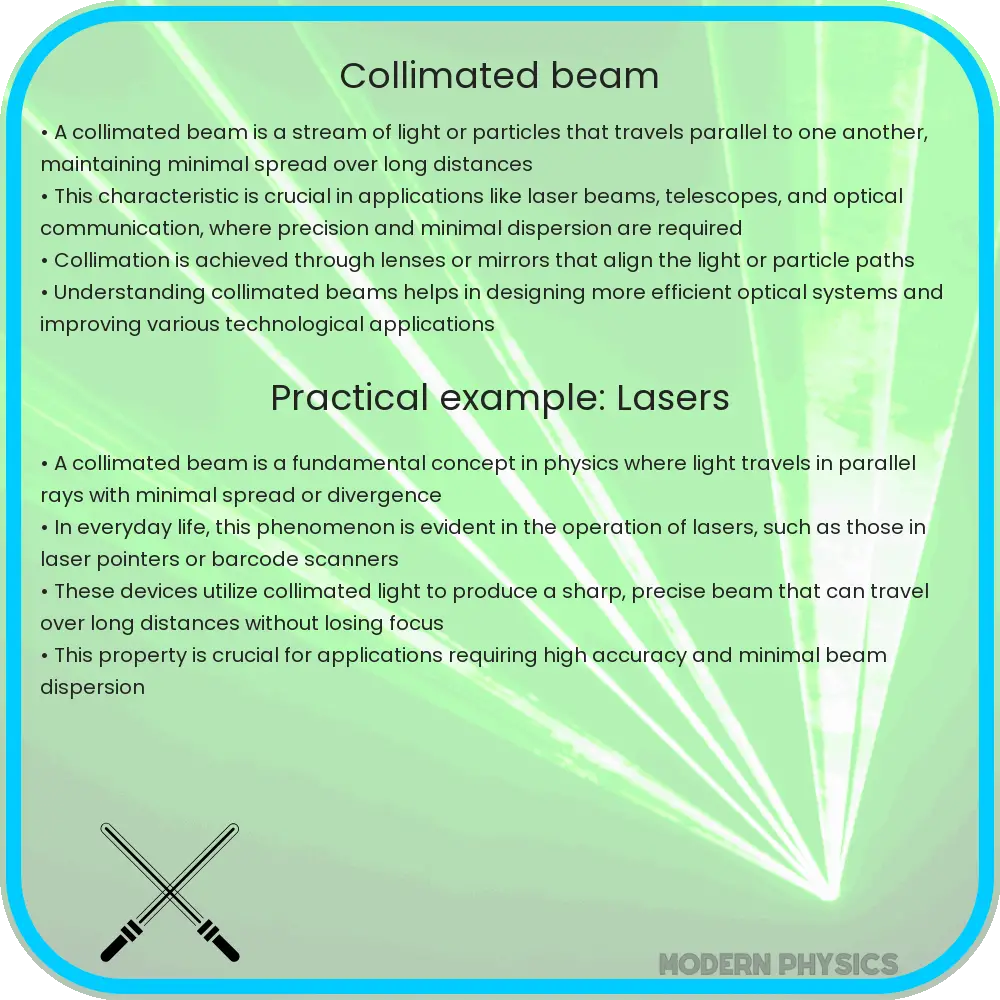Explore the precision, uniformity, and directionality of collimated beams, their applications, challenges, and future prospects in optical technology.

Understanding Collimated Beams: Precision, Uniformity, and Directionality
Collimated beams are a cornerstone in the fields of optics and laser technology, celebrated for their precision, uniformity, and directionality. By definition, a collimated beam of light is one in which the rays are parallel, allowing the beam to spread minimally over long distances. This unique property makes collimated beams ideal for a wide range of applications, from laser cutting and medical procedures to telecommunications and scientific research.
The Science Behind Collimation
The process of collimation involves the manipulation of light waves to travel in parallel lines. This is achieved using collimating lenses or mirrors that correct the divergence of light waves emanating from a point source. The result is a beam of light that maintains its intensity and focus over greater distances than a non-collimated beam, which would disperse and lose intensity rapidly.
Key Characteristics of Collimated Beams
- Precision: Collimated beams can be directed with high accuracy, making them indispensable in applications requiring precise targeting, such as in laser surgery and optical measurements.
- Uniformity: The parallel nature of the light rays in a collimated beam ensures that the beam’s intensity is uniform across its cross-section. This uniformity is crucial for applications like imaging and holography, where consistent illumination is required.
- Directionality: The ability to maintain a narrow focus over long distances without significant divergence is what sets collimated beams apart. This directionality is essential for communication systems, including fiber optics, where the light needs to travel long distances with minimal signal loss.
Applications and Advancements
Collimated beams have revolutionized multiple industries, enabling advancements in technology and science that were previously unimaginable. In the medical field, for example, collimated laser beams are used for precise surgical procedures, reducing recovery time and improving outcomes. In the realm of entertainment, collimated beams create stunning visual effects in concerts and theaters. Furthermore, in scientific research, they are pivotal in experiments that require precise measurements and control, such as in optical tweezers and interferometry.
The ongoing evolution of collimation technology continues to expand the capabilities and applications of collimated beams. With advancements in optical materials and design, we can expect even greater precision, uniformity, and directionality in future applications, further cementing the role of collimated beams in the technological landscape.
Challenges and Solutions in Collimation Technology
Despite the significant advantages offered by collimated beams, achieving and maintaining perfect collimation poses challenges. The process requires precise alignment of optical elements, and even minor imperfections can result in beam divergence. Moreover, external factors such as temperature fluctuations and mechanical vibrations can impact the stability of collimation over time. Innovations in optical design, including adaptive optics and feedback control systems, have been developed to counter these challenges, ensuring consistent beam quality under varying conditions.
Future Prospects
The future of collimation technology holds promising advancements that could further enhance the precision, uniformity, and directionality of collimated beams. Developments in nano-optics and photonics are paving the way for more compact, efficient collimating devices. Additionally, the integration of artificial intelligence and machine learning in optical systems is anticipated to automate and optimize the collimation process, leading to smarter, self-adjusting systems that can maintain optimal performance in real-time.
Environmental and Safety Considerations
As with any technology involving intense light sources, there are environmental and safety considerations to bear in mind. Proper handling and protective measures are essential to prevent accidental exposure to high-intensity beams, which can pose risks to both human health and the environment. Compliance with safety standards and regulations is paramount, as is ongoing research into minimizing the ecological footprint of collimation technologies.
Conclusion
Collimated beams stand as a testament to the incredible strides made in optical technology, offering unparalleled precision, uniformity, and directionality. Their impact stretches across multiple disciplines, driving innovation and enhancing capabilities in medicine, communication, entertainment, and research. Despite the challenges associated with achieving perfect collimation, ongoing advancements in optical engineering and materials science continue to push the boundaries of what is possible. As we look toward the future, the evolving landscape of collimation technology promises to bring about even more sophisticated applications, further embedding collimated beams as an indispensable tool in the scientific and technological toolkit. With a vigilant eye on safety and environmental impact, the journey of collimated beam technology is poised to continue its trajectory of growth and discovery, illuminating the path to new horizons.
